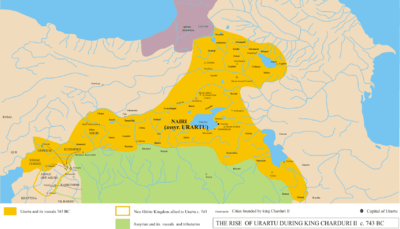Urartu–Assyria War
| Urartu-Assyria War | |||||
|---|---|---|---|---|---|
 | |||||
| |||||
| Belligerents | |||||
| Urartu | Neo-Assyrian Empire | ||||
| Commanders and leaders | |||||
|
Rusa I, Argishti II, Rusa II, Sardur III, Erimena, Rusa III, Rusa IV |
Tiglath-Pileser III, Sargon II, Sennacherib, Esarhaddon, Ashurbanipal | ||||
| Strength | |||||
| no reliable estimates | no reliable estimates | ||||
The Urartu–Assyria War was a conflict between the Kingdom of Urartu and the Neo-Assyrian Empire. The war began around 714 BC, with the invasion of Urartu by the Assyrian King Sargon II.[1] Sargon led multiple offensives deep into Urartuan territory, amassing numerous victories in the war. Following his death, however, Urartuan Kings Argishti II and Rusa II launched many successful counterattacks, reclaiming Urartu's lost territory and gaining some from Assyria. However, their successors suffered multiple major defeats, resulting in Urartu becoming an Assyrian client state.
Background
The Hurrian speaking Iron Age Kingdom of Urartu began its rise to power in the mid-9th century BC. Within a century, the relatively new state had conquered the majority of what were to later be known as the Armenian Highlands. However, the Assyrian King Tiglath-Pileser III saw the rising Kingdom of Urartu as a growing threat to the safety of his kingdom. The Assyrian leadership deemed that they must end this threat through direct confrontation with the young kingdom.[2]
Early stages
In 714 BC, King Sargon II led an offensive into Urartuanian territory. His early victories, especially at the Battle of Lake Urmia and his ransack of the head Uratuan temple at Mushashir, almost caused total defeat for his Uratuan counterpart, King Rusa I.[3]
Uratuan counterattack
After Sargon's death in 706 BC, King Rusa's successor, Argishti II, launched a major counterattack, with his forces driving the Assyrians back across the pre-war border and deep iinto Assyrian colonies in northwestern Ancient Iran, reconquering major towns and cities around Lake Urmia, including Mushashir, Ushnu, and Tepe..[3]
Assyrian victory

After the Uratuan victories during the early part of King Argishti II's reign, Urartu experienced a "Golden Age" characterized by a lengthy peace and economic prosperity throughout the remainder of Arghisti's reign and the entire rule of his successor, Rusa II.[3] However, Kings Rusa III and Rusa IV were repeatedly defeated by the Assyrians. This ultimately turned Urartu into an Assyrian client state, used as a buffer on the northern borders of this powerful empire.
Aftermath
Both states did not last long after the end of the war. Assyria descended into a series of bitter internal civil wars after 627 BC, leaving it open to attack. The Assyrian capital, Nineveh, was sacked and destroyed by a coalition of its former subject peoples, the Babylonians, Chaldeans, Medes, Persians, Scythians and Cimmerians, in 612 BC, with Assyria finally falling by 605 BC. The Medes and Scythians then turned on the remnants of Urartu, destroying it c. 590 BC.